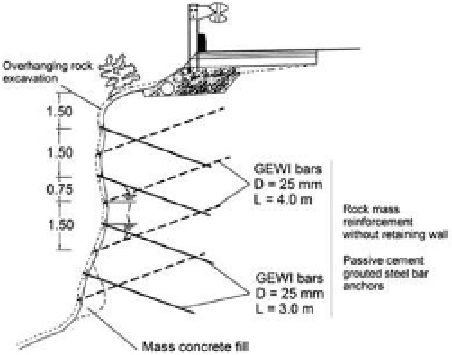Environmental Engineering Reference
In-Depth Information
Table 1. Geomechanical design properties of welded
phonolitic ignimbrites in the working area.
Geomechanical
parameter
Design
value
Unit
Moist unit weight
(kn/m
3
) 20.21
γ
saturated unit weight
(kn/m
3
) 21.50
γ
sat
Basic joint friction
angle
57.2
φ
BJ
(°)
Residual joint friction
angle
41.5
φ
RJ
(°)
Rock mass friction
angle
φ
(°)
46.6
Rock mass cohesion
c
(kPa)
35.0
Joint Roughness
coeff.
JRc
20
8
Joint wall comp.
strength
Jcs
(MPa)
12.0
Figure 4. cross section of the stabilization system on
the rock slope sections without retaining wall.
Ucs (intact rock)
σ
ci
(MPa)
43.0
Point load Test
strength
is
(MPa)
2.5
that mono-bar anchors have shown less suscepti-
bility to corrosion than cable anchors as a result
of groundwater attack (shaqour 2006). on the
other hand, the utilization of mass concrete
facilitates the construction procedure, especially
in a slope with complicated access to working
site and high irregularity to systematize a steel
reinforcement.
- achievement of elevated resistant reaction
force in order to guarantee a specified factor of
safety.
- The batter of the wall with a rear face mean
gradient of 1h/8V takes advantage of the verti-
cal stabilizing force due to backfill. Designing a
stair-shaped rear face simplifies the construction
using horizontal lifts.
- The election of a cast-in-place mass concrete
retaining structure, in preference to pre-cast con-
crete, is due to difficulties with standardizing pre-
cast elements because of rock unevenness, with
presence of cavities in the rock mass, reduced
foundation spaces and difficult excavations.
a previous excavation of overhanging rock and
breached or detached blocks, as well as bush clear-
ing (in order to avoid roots growing in rock cracks)
and wall drainage and waterproofing with bitumi-
nous products have been also prescribed.
hoek-Brown
parameter
m
-
0.851
hoek-Brown
parameter
s
-
1.27 × 10
-3
elastic modulus
(laborat.) (intact rock)
(GPa)
9.261
Ε
i
estimated elastic
modulus (rock mass)
Ε
(GPa)
2.985
Rock Quality
Designation
RQD
(%)
80
Rock Mass Rating
RMR
57 (class
iiia)
Q index
Q
4
slope Mass Rating
sMR
53 (class
iiia)
combinations specified in spanish standards iaP
(1998) and ehe (2008). lateral earth pressures on
the wall can be calculated (whether the mass rock
is stable) applying “silo effect” earth pressure the-
ory due to backfill confinement between the rock
mass and the new wall structure. This assumption
allows to consider more reduced active pressures
than classical Rankine and coulomb theories,
being a more realistic approach in this particular
case, because of the limited width of the confined
backfill. Previously, conditions to utilize this meth-
odology were checked.
The rock slope safety against overall and local
rock wedge and planar instabilities created by
jointing has been verified taking into account the
reaction force introduced by the anchored gravity
retaining wall. This force was calculated with the
condition of assuring a specified global Factor of
safety (F
s
= 1.5) with respect to overall and local
slope failure, according to limit state design methods
for persistent design situation and quasi-permanent
load combination. safety factors depend on the
3.2
Stability analysis and verifications
Design parameters of the welded phonolitic ign-
imbrite rock mass were estimated from de geome-
chanical and geotechnical study and are summarized
in Table 1.
in project, stability checks for the anchored walls
have been performed, assuming earth pressures of
the backfill placed over tie back level and the traffic
surcharge according to design approaches and load



























